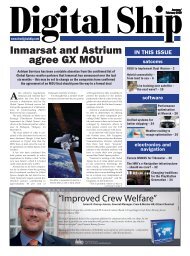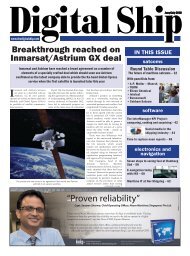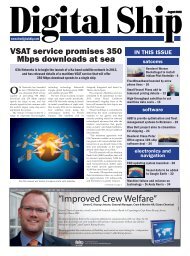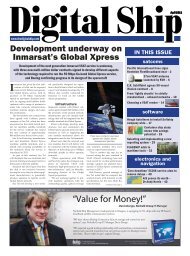Digital Ship
Digital Ship
Digital Ship
You also want an ePaper? Increase the reach of your titles
YUMPU automatically turns print PDFs into web optimized ePapers that Google loves.
<strong>Digital</strong> <strong>Ship</strong>SHIP partners, Danaos and Wärtsilä.In the UK, BMT led a sub project calledFLAGSHIP-HCA which addressed theprocess of surveys and dry-dock repairs.This resulted in the German partner,Germanischer Lloyd introducing a newcommercial tool called ‘Hull Manager’.Germanischer Lloyd also led a projectcalled FLAGSHIP-EEM which focussed onenergy savings during sailing, which hasresulted in a patent being secured to covera new process of measuring power consumptionduring operations. Commercialproducts are planned for 2011.Alarm Filtering was addressed by theFLAGSHIP-iCAS sub project, led byKongsberg in Norway, dealing with theproblem of large cascades of alarms.Kongsberg says that the market hasresponded very positively to the technology,and that several orders have alreadybeen taken.Led by MJC2, a UK business, FLAGSHIP-RTS addressed real time container schedulingand matching imports and exportsin order to save unnecessary truck trips.FLAGSHIP says that this has alreadyresulted in large savings for China<strong>Ship</strong>ping and the Port of Valencia, whileseveral commercial solutions have sincebeen introduced.A sub-project called FLAGSHIP-DSSled by the University of Strathclyde in theUK dealt with the determination of anIndex of Vulnerability.bandwidth*@Firewall Acceleration & Compressionbandwidth over FB500 terminal@n requirements in one boxway to communicateA secure networkCrewnetIts presentation to the crew in a recent7-week demonstration led to an immediateimprovement in practices which sawthe Index fall by 45 per cent in a singleweek - six orders from a wide variety ofparties have already been received.Continued innovationWith the project now having come to aclose, Herman de Meester, project coordinatorfor FLAGSHIP and deputy secretarygeneral of the European Community<strong>Ship</strong>owners' Association (ESCA), praisedthe work done by the partners over the sixyears of maritime research and development,and expressed his satisfaction at thenew technologies that have been introducedto the market as a result.“With input from organisations asdiverse as shipowners, shipyards, equipmentmanufacturers and classificationsocieties and research institutes the subprojectsrun under the FLAGSHIP bannerhave been able to deliver tangible resultsthat have already added value to theEuropean maritime industry,” he said.“Integrated R&D in the maritimedomain is necessary in order to delivernew solutions in the fields of environment,efficiency and safety.”“Furthermore there is an absolute needfor innovation in order to deliver thesenew solutions in a cost effective and commerciallyviable way so that the maritimeindustry in the European Union can stayFor your smart@sea,please contact your service providerand ask for Station711 smart@seaahead of its competitors across the world.”By most measurements it seems to bequite clear that the project has been a success,with Mr de Meester pointing to thefact that, while all 15 FLAGSHIP sub-projectswere established with specific aims,only three of them have not quite deliveredwhat was expected.“As this is a research project, a successrate of around 50 per cent would have beenexcellent, considering the cutting edgework that was undertaken – the 80 per centsuccess rate achieved in practice is testamentto the hard work and diligencedemonstrated by the partners,” he said.“As well as meeting the vast majority ofthe objectives associated with sub-projectdelivery FLAGSHIP delivered a raft ofother benefits. New relationships betweenpartners in the project have been established,a stronger EU platform for furtherimprovement in maritime business andnew standards has been developed andimportant input to IMO legislation hasbeen made.”“Furthermore we have strengthenedEuropean maritime competitiveness as wellas raising awareness, knowledge and theinterest in the maritime business sector.”Mr de Meester notes that, while he considersthe European maritime business sectorto already be very efficient and wellplaced to drive innovation, generating majorimprovement across the sector may sometimesrequire a shake up of the “status quo.”“There are some issues that can onlybe addressed and improvements made ifeverybody pulls together,” he said. “It issimply not possible for a simple organisationto generate enough momentum onits own.”“Innovation and exchange of ideasbetween sectors and markets that wouldnot usually interact is a huge positive forwww.stelvio.comwww.canfornav.comFLAGSHIP and would be impossible toachieve in a forum that promotes opencommunication and sharing of informationwithout the structure created by the EU.”EU investment in the FLAGSHIP projecthas obviously been a factor in drivingits success, though Mr de Meester is keento point out that this kind of public moneycannot be a substitute for private enterpriseinvestment in R&D.“In fact, the Commission support onlyrepresents about 4-5 per cent of the totalresearch funding in the European maritimecluster, mainly at company level,” heexplained.“However, maritime is a very competitivebusiness and there are often instanceswhen restrictions on time or money withinindividual organisations preclude takingon larger and more all-encompassingR&D tasks.”Looking to the future after FLAGSHIP,Mr de Meester hopes that new researchand innovation projects will come in totake its place.He particularly highlights IMO initiativesand the European Commission’s2050 transport strategy for Europe, whichhave both targeted a reduction in greenhouseemissions of 75-80 per cent over thenext 39 years, as areas where continuedresearch would be welcome.“When this is viewed alongsideFLAGSHIP’s achievements in reducing fuelconsumption by 1-5 per cent and reducinggreenhouse gases by 2-4 per cent, as well asenhancing engine performance by up to 5per cent it becomes clear how much morework needs to be done,” Mr de Meester said.“However it also highlights the importanceof research projects like FLAGSHIPwhich are doing the hard work required todevelop solutions that will help address themaritime challenges of the 21st century.” DSStelvio and Canfornav launchemission reporting systemStelvio, a Montreal based software developmenthouse, has jointly developed amaritime emissions reporting modulewithin its <strong>Ship</strong>Decision system, in conjunctionwith Canadian ship owner andoperator Canfornav.In joining the project Canfornav soughtto automate the collection of its emissionsperformance data, which is annually reportedin compliance with the Green Marineemissions reporting guidelines. GreenMarine, of which Canfornav is a memberand <strong>Ship</strong>Decision a partner, is a voluntaryenvironmental programme of the Canadianand American marine industry.<strong>Ship</strong>Decision is a maritime ‘Software asa Service’ (SaaS) solution that is designedto support the organisation of the sharingand use of information among businesspartners in the maritime sector.Accessible via internet and protectedthrough encryption, <strong>Ship</strong>Decisionprocesses data, documents and communicationsrelated to individual voyages.Stelvio and Canfornav collaborativelyset up the <strong>Ship</strong> Decision ComprehensiveEmissions Performance Reporting (CEPR)Module. The companies state that theCEPR Module compiles operational datafrom vessel records, making it faster andsimpler to generate emissions reports on aper vessel basis, as well as across the fleet.The reporting technology addressespollutant air emissions, specifically: SOxemissions (level 3); and NOx emissions(level 3) and also calculates GHG emissions(levels 3,4,5).“By automating the collection of thedata we need for Green Marine reporting,we can monitor the performance of ourvessels on a daily basis,” says Errol Francis,vice president operations, Canfornav.“It also allows us to provide a carbonfootprint, on a daily basis, to customerswho want that information.”Albert Carbone, president and CEO ofStelvio, also commented that his company“had already deployed an off-line reportingmodule for Noon Reports, which is usedacross the fleet. The Emissions Reportingproject was a natural offshoot of that.”“We saw the opportunity to build aModule that would not only permitCanfornav to meet their annual GreenMarine reporting requirements, but thatcould also give them a daily snapshot oftheir ‘Green Position’.”<strong>Digital</strong> <strong>Ship</strong> June/July 2011 page 29








